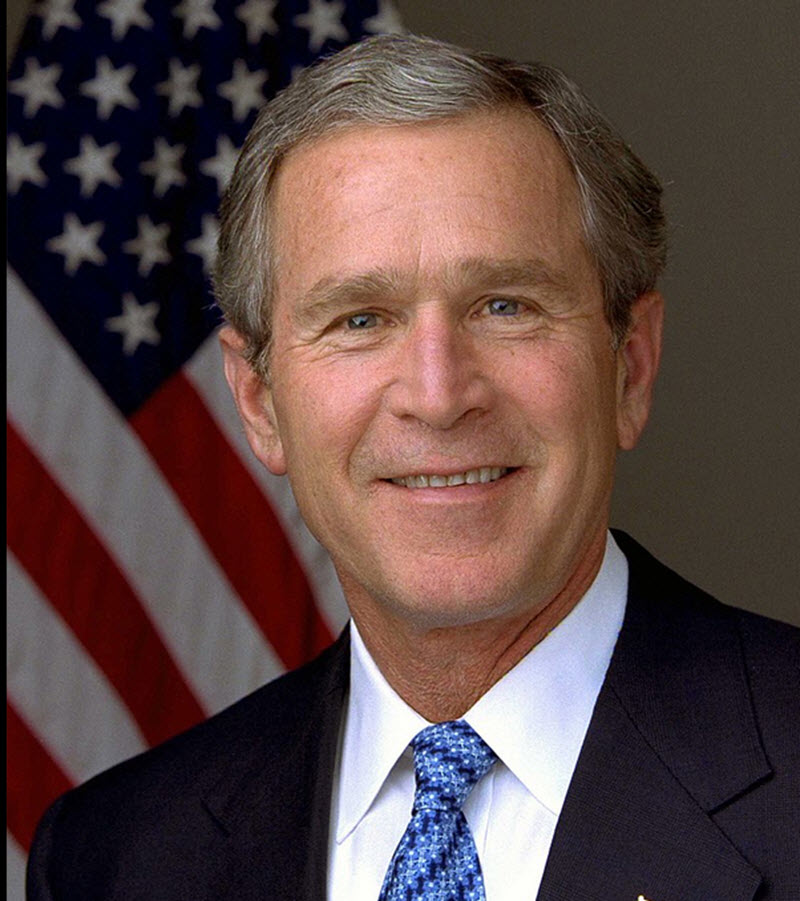George W. Bush
Contents
George W. Bush, the 43rd President of the United States, served two terms from 2001 to 2009. Born on July 6, 1946, in New Haven, Connecticut, he is the eldest son of George H. W. Bush, the 41st President of the United States, and Barbara Bush, making him part of a prominent political family. His paternal grandfather, Prescott Bush, was a U.S. Senator from Connecticut.
George W. Bush’s presidency remains a period of significant debate and analysis, with opinions on his legacy deeply divided. Supporters point to his leadership during the challenging times following the terror attacks on September 11, 2001, and also his efforts to combat HIV/AIDS in Africa, while critics point to the Iraq War and the Bush administration’s response to both Hurricane Katrina and the financial crisis.

Short facts about George W. Bush
- George W. Bush served two terms as president of the United States, from January 20, 2001 to January 20, 2009. He was preceded by Bill Clinton and succeeded by Barack Obama. His Vice President was Dick Cheney.
He is a member of the Republican Party.
He and Laura Welch married in 1977. They have two children; Barbara and Jenna.
Early Life and Education
George Walker Bush was born in Connecticut but grew up in Texas, in Midland and Houston. The family had five children, including one daughter who died from leukaemia at the age of three.
When Bush had finished seventh grade in Midland, the family moved to Houston, and he continued his education there. Before college, he spent two years at the Kinkaid School, a college-preparatory school near Houston.
Bush was educated at Phillips Academy in Andover, Massachusetts. He went on to earn a bachelor’s degree in history from Yale University in 1968 and later obtained an MBA from Harvard Business School in 1975, becoming the first U.S. president with an MBA.
In his twenties, Bush flew warplanes in the Texas Air National Guard.
Business and Political Career
Before his political career, Bush worked in the oil industry, founding Arbusto Energy in 1977. His political career began in earnest when he ran unsuccessfully for the U.S. House of Representatives in 1978. He later co-owned the Texas Rangers baseball team, before being elected as the Governor of Texas in 1994, where he served until 2000.
Bush was the 46th Governor of Texas, in office from January 17, 1995 to December 21, 2000. His lieutenants were Bob Bullock and Rick Perry. Rick Perry would succeed him and become the 47th Governor of Texas.
As governor, Bush sponsored legislation for tort reform, reformed the criminal justice system, and increased education funding. He also promoted wind-power, and during his governorship Texas became the contry´s leading producer of wind-powered electricity.
Presidency
Bush won the presidency in 2000 in one of the closest and most controversial elections in U.S. history, ultimately decided by the Supreme Court in Bush v. Gore. He was re-elected in 2004, defeating Democratic challenger John Kerry.
Examples of Significant Events During His Presidency:
- The September 11, 2001, attacks: Bush’s presidency was defined early on by the terrorist attacks on September 11, 2001. His response included launching the War on Terror, which led to the invasion of Afghanistan to dismantle Al-Qaeda and remove the Taliban from power.
- Iraq war: In 2003, Bush ordered an invasion of Iraq, based on the belief that the Iraqi government, led by Saddam Hussein, possessed weapons of mass destruction (WMDs) and posed a threat to the U.S. and its allies. The WMDs were never found, and the war and its aftermath have been subjects of significant controversy and debate.
- Hurricane Katrina: Bush’s handling of the aftermath of Hurricane Katrina in 2005 was criticized for the perceived delayed response and inefficiency in aiding the affected regions, particularly New Orleans.
- Economic policies and the 2008 financial crisis: Bush implemented significant tax cuts and pursued deregulatory financial policies. His second term saw the onset of the 2008 financial crisis, which became the worst economic downturn since the Great Depression. In response, Bush signed into law various measures aimed at stabilizing the financial system, including the controversial Troubled Asset Relief Program (TARP).
Energy policies
In 2006, Bush announced his Advanced Energy Initiative, a project aimed at increasing energy development research. In his 2007 State of the Union Address, Bush renewed his pledge to work toward making the United States less dependant on foreign oil by reducing fossil fuel use and increasing non-fossil fuel production.
In 2008, Bush lifted a ban on offshore drilling, as a response to unusually high gasoline prices. The action was largely symbolic, as the federal law banning offshore drilling remained in place.
In his 2008 State of the Union Address, Bush announced that the U.S. would commit $2 billion to an new international fund to promote clean energy technologies and fight climate change.
Environmental policies
The Kyoto Protocol
Upon taking office in 2001, Bush declared his opposition to the Kyoto Protocol.
Energy projects
In May 2001, Bush used an executive order to form an interagency task force to streamline energy projects in the United States.
Clear Skies Act of 2003
Bush proposed the Clear Skies Act of 2003. Many experts argued that this new law would have weakend the original Clean Air Act. The Clear Skies Act of 2003 was not enacted.
Marine preservation
In 2006, Bush decleared the Northwestern Hawaiin Islands a National Monument, thereby creating the largest marine reserve in the world. The monument, named Papahānaumokuākea Marine National Monument, spans 84 million acres and is home to several endemic species.
Post-Presidency
After leaving office, Bush returned to Texas and involved himself in various humanitarian efforts, including work on global health issues through the George W. Bush Presidential Center. He also took up painting, a hobby through which he has expressed himself and honored military veterans.
This article was last updated on: March 22, 2024
